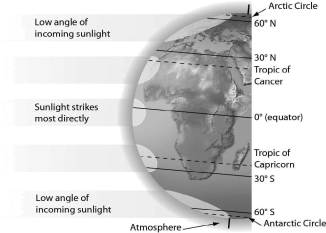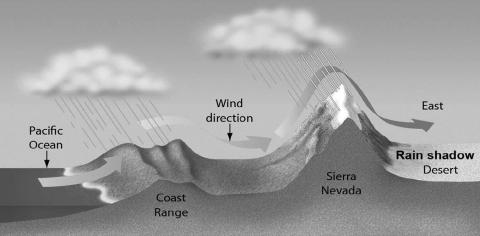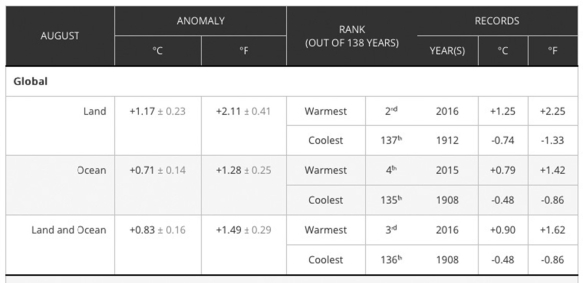A) carbon dioxide and other greenhouse gases allowing more solar radiation to penetrate Earth's surface
B) carbon dioxide and other greenhouse gases slowing the escape of UV radiation from Earth
C) the loss of ozone that trapped cooling UV radiation in the atmosphere
D) carbon dioxide and other greenhouse gases slowing the escape of heat from Earth
Correct Answer

verified
Correct Answer
verified
Multiple Choice
What level of ecology is concerned with the adaptations of individuals?
A) community
B) organismal
C) ecosystem
D) population
Correct Answer

verified
Correct Answer
verified
Multiple Choice
From the figure, which part of Earth receives the greatest intensity of solar radiation? 
A) Tropic of Cancer and Tropic of Capricorn
B) Equator
C) North and South Poles
Correct Answer

verified
Correct Answer
verified
Multiple Choice
Malaria is an infectious disease transmitted to humans from a parasite that infects mosquitoes that feed on humans. World health officials have concerns that climate change may impact the transmission of malaria into tropical highland areas in Africa. If these concerns turn out to be valid, they would imply that global climate change ________.
A) affects the distribution of species
B) will negatively impact the transmission of malaria only in Africa
C) affects freshwater and marine biomes
D) will enable scientists to more easily control the spread of malaria
Correct Answer

verified
Correct Answer
verified
Multiple Choice
In suburban areas with a high density of humans, it is necessary to have a well-functioning wastewater treatment system. If engineers wanted to create a wastewater treatment system that takes advantage of natural resources, they should consider incorporating ________ into their plan.
A) wetlands
B) oceans
C) rivers
Correct Answer

verified
Correct Answer
verified
Multiple Choice
What can moderate climate by absorbing heat when the air is warm and releasing heat when the air is cold?
A) clouds and tropic forests
B) glaciers and deserts
C) mountains and grasslands
D) oceans and lakes
Correct Answer

verified
Correct Answer
verified
Multiple Choice
Suppose that a group of climate scientists claims that they can predict future impacts of global climate change with 98% accuracy. Why should you be skeptical of this claim?
A) They do not have reliable methods to measure this change.
B) Their predictions are based on incomplete information about species diversity and interactions of living organisms with each other and with their environments.
C) They should be focusing their predictions based only on climate change in the polar regions where the greatest effects of climate change are experienced.
D) They have not accounted for abiotic factors that affect global climate change in their predictions.
Correct Answer

verified
Correct Answer
verified
Multiple Choice
What is one important difference between savannas and temperate grasslands?
A) Savannas only rarely experience fires.
B) Temperate grasslands are mostly treeless.
C) Savannas are inhabited by grazing mammals.
D) Temperate grasslands have nutrient-poor soil.
Correct Answer

verified
Correct Answer
verified
Multiple Choice
Scenario CO2 is not the only greenhouse gas (GHG) that impacts global climate change. Other GHGs may be equally or more effective than CO2 at trapping heat on Earth. Climate scientists determine how much a GHG may impact global warming based on two factors: the efficiency with which a GHG absorbs energy (i.e., traps heat on Earth) and the length of time (in years) that the gas remains in the atmosphere. A unit of measurement called the Global Warming Potential (GWP) is used to describe how much energy a GHG absorbs over a specific period of time (100 years is a standard time frame) . All GWP values of GHGs are compared to the GWP of CO2, which is given a value of 1. -CH4 has a GWP over 20 times higher than CO2. However, CH4 emitted today lasts for only about a decade in the atmosphere, while the GWP of CO2 can last for thousands of years. What is a possible reason that CH4 can have such a high GWP as compared to CO2?
A) The 100-year time frame is too short of a time frame to compare CH4 and CO2.
B) CH4 absorbs more energy than CO2.
C) CH4 is less efficient at trapping heat on Earth.
D) CH4 is not a proven greenhouse gas.
Correct Answer

verified
Correct Answer
verified
Multiple Choice
Which biome is one of the most biologically productive of all biomes?
A) open oceans
B) estuaries
C) temperate grasslands
D) coniferous forests
Correct Answer

verified
Correct Answer
verified
Multiple Choice
Which of these biomes are maintained by fire?
A) temperate broadleaf forests and chaparral
B) chaparral and savannas
C) deserts and chaparral
D) savanna and temperate grasslands
Correct Answer

verified
Correct Answer
verified
Multiple Choice
In an aquatic ecosystem, what name is given to the region where photosynthesis can occur?
A) pelagic zone
B) aphotic zone
C) benthic realm
D) photic zone
Correct Answer

verified
Correct Answer
verified
Multiple Choice
The figure indicates that ________. 
A) mountains can block the flow of moist air from a coast, causing radically different climates on opposite sides of a mountain range
B) the direction of wind affects how much moisture evaporates in the photic zone of the Pacific Ocean
C) rainfall creates freezing temperatures in mountain ranges
D) groundwater runoff causes massive erosion at the base of mountain ranges
Correct Answer

verified
Correct Answer
verified
Multiple Choice
Global warming may trigger all but one of these results to occur. Choose the EXCEPTION.
A) changes in the breeding seasons of some species
B) increased forest clearing for agricultural purposes
C) melting permafrost
D) catastrophic wildfire seasons
Correct Answer

verified
Correct Answer
verified
Multiple Choice
Which question would be investigated by someone who studies population ecology?
A) How do phosphoruscycling and solar energy affect water temperature and phytoplankton growth in aquatic ecosystems?
B) How does a change in vocal signals helpurban great tits (Parus major) survive in urbanized areas?
C) How does habitat destruction affect growth and density of multiple amphibian species?
D) How does the structure of a cactus plant enable it to avoid desiccation in hot, arid environments?
Correct Answer

verified
Correct Answer
verified
Multiple Choice
 The data in this table describe the average global temperature anomalies measured in August 2017 for Land, Ocean, and Land/Ocean combined. NOAA (the National Oceanic and Atmospheric Administration) defines a temperature anomaly as: "a departure from a reference value or long-term average. A positive anomaly indicates that the observed temperature was warmer than the reference value, while a negative anomaly indicates that the observed temperature was cooler than the reference value." (https://www.ncdc.noaa.gov/monitoring-references/faq/anomalies.php) What can you conclude from these data?
The data in this table describe the average global temperature anomalies measured in August 2017 for Land, Ocean, and Land/Ocean combined. NOAA (the National Oceanic and Atmospheric Administration) defines a temperature anomaly as: "a departure from a reference value or long-term average. A positive anomaly indicates that the observed temperature was warmer than the reference value, while a negative anomaly indicates that the observed temperature was cooler than the reference value." (https://www.ncdc.noaa.gov/monitoring-references/faq/anomalies.php) What can you conclude from these data?
A) Land, Ocean, and Land/Ocean combined all showed negative anomalies.
B) Land, Ocean, and Land/Ocean combined all showed positive anomalies.
C) Land temperature anomalies for 2017 are the highest recorded in 138 years.
D) Land/Ocean combined anomalies for 2017 are the coldest recorded in 138 years.
Correct Answer

verified
Correct Answer
verified
Multiple Choice
Most of the temperate grassland in North America has been converted to ________.
A) cities
B) farmland
C) national parks
D) small neighborhoods
Correct Answer

verified
Correct Answer
verified
Multiple Choice
An effect of deforestation has been to ________.
A) decrease the amount of carbon dioxide in the atmosphere
B) increase the amount of carbon dioxide in the atmosphere
C) increase the rate at which carbon dioxide is incorporated into organic material
D) decrease the rate of carbon dioxide production through cellular respiration
Correct Answer

verified
Correct Answer
verified
Multiple Choice
Scenario CO2 is not the only greenhouse gas (GHG) that impacts global climate change. Other GHGs may be equally or more effective than CO2 at trapping heat on Earth. Climate scientists determine how much a GHG may impact global warming based on two factors: the efficiency with which a GHG absorbs energy (i.e., traps heat on Earth) and the length of time (in years) that the gas remains in the atmosphere. A unit of measurement called the Global Warming Potential (GWP) is used to describe how much energy a GHG absorbs over a specific period of time (100 years is a standard time frame) . All GWP values of GHGs are compared to the GWP of CO2, which is given a value of 1. -In this scenario, how would you best describe CO2?
A) It is a baseline comparison for the GWP values of all other GHGs.
B) It is a greenhouse gas whose GWP value is dependent upon the GWP values of all other GHGs.
C) It is the greenhouse gas that is the most efficient at trapping heat on Earth.
D) It is the greenhouse gas that is the least efficient at trapping heat on Earth.
Correct Answer

verified
Correct Answer
verified
Multiple Choice
Latitudes between the tropics and the Arctic Circle and the Antarctic Circle are called ________.
A) tropical zones
B) temperate zones
C) polar regions
D) savanna ecosystems
Correct Answer

verified
Correct Answer
verified
Showing 21 - 40 of 56
Related Exams